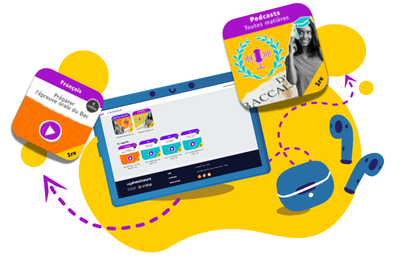Minorities in the US under Trump's mandate
- Fiche de cours
- Quiz et exercices
- Vidéos et podcasts
Découvrir un aspect de la notion « Diversité et inclusion ».
- Les États-Unis d’Amérique sont considérés comme un melting pot, c’est-à-dire que différentes communautés cohabitent ensemble.
- Cependant, en dépit d’une histoire marquée par l’immigration, les minorités sont discriminées aux États-Unis et, en particulier, la communauté noire, et ce même avec l’abolition de l’esclavage et le mouvement des droits civiques au XXe siècle.
- L’ancien président des États-Unis Donald Trump a voulu renforcer le mur qui se trouve entre les États-Unis et le Mexique pour empêcher l’immigration illégale.
- Cependant, les statistiques montrent que l’immigration illégale recule.
L'histoire des États-Unis et ses rapports avec les minorités
The United States of America has always known waves of immigration. When the Pilgrims arrived on the Mayflower, they met the only occupants of the country: the American Indians.
In 1620 a group of English puritans who were persecuted because of their religious beliefs (Calvinism) left England for the new world. They are known as the Pilgrims or the Pilgrim Fathers. They established their colony in Plymouth, Massachusetts on September 16, 1620.
Since then Irish, Jewish, Italian, Asian, Hispanic and other communities have settled in America. No wonder the country is compared to a melting pot.
Did the situation changed when Donald Trump was President (2017-2020)? How were the newcomers considered then?
To start with, we can unfortunately say that the Blacks in the US still do not have the same rights as the Whites. They even think that equality will never be reached and that there will always be differences. 40% say that the country has not made enough progress since the abolition of slavery 150 years ago.
And, according to 60% of Americans, the situation is
getting worse since Trump was elected in 2017. And
a few see race relations improving in a near
future.
But what is more dramatic nowadays is that people (65%)
do not hesitate to express racist views without any
shame.
A lot of people – about 80% –
allege that the black community still suffers from
the burden of slavery which considerably affects
them (racism, work discrimination, police brutality,
etc.).
Like Afro-Americans (12%), Hispanics (17%) and Asians
(5%), whose skin colour singles themselves out from the
rest of the population, suffer from racism, too. They
have difficulty finding a job or being integrated in
the American society.
Unfortunately too many series convey a wrong message:
non-Whites are often depicted as lower-class members
who make a living as housemaids, janitors or…
gang leaders!
Whereas 37% of American people thought Barack Obama had
made progress on race relations when he was President
(2009–2017), only 15% think Donald Trump had made
progress towards improving the situation.
In fact, being white in America helps a lot when it
comes to a person’s ability to get ahead and
Trump, whose dream was to stop immigration, was not
willing to make things better.
During his 2016 election campaign, Trump argued that a bigger wall was needed between Mexico and the USA. In the beginning, the wall was supposed to cover the entire length, being almost 2,000 miles (3 kilometers). But he announced later he would cover only half of the distance, mountains and rivers taking care of the rest.
Since the end of the 1980s, barriers are built between the 2 countries to prevent illegal drugs transportation and immigration. In 2011 the Department of Homeland Security stated that the barriers are almost 650 miles length (almost 1 kilometre).
But why such a wall? And is there a crisis of legal
immigration on the southern border? If we have a look at
the figures, we must say no.
Indeed, in 2000, nearly 1.7 million people crossed
the border whereas in 2015, before Trump was elected, the
number had fallen to 400,000.
It is also important to note that, according to the Pew Research Center, the number of immigrants living in the US illegally has actually declined since 2007.
And illegal border crossings are not limited to the southern border, migrants also try to enter the US through the Canadian border and the coastal border.
Most of the time, people trying to cross the border do it because they flee violence in their countries: poverty, gang violence, organised crime, corruption, murders, insecurity, etc. It was the case in 2007 when a caravan of 7,000 people from Honduras, Guatemala and El Salvador arrived at the border. And Donald Trump called it an invasion.
Even though only a part of the wall has been erected, harsh measures were taken to dissuade migrants from entering the US. Indeed, the authorities did not hesitate to separate the families and children were detained in squalid conditions.
This wall is unfortunately not an isolated case. We have to know that about 70 walls have been built in the world since the end of the Second World War.
There are good news though: even if nobody knows for sure how much the wall would cost, it is likely to be blocked by the Senate. And 58% of Americans are opposed to its construction.

Des quiz et exercices pour mieux assimiler sa leçon
La plateforme de soutien scolaire en ligne myMaxicours propose des quiz et exercices en accompagnement de chaque fiche de cours. Les exercices permettent de vérifier si la leçon est bien comprise ou s’il reste encore des notions à revoir.

Des exercices variés pour ne pas s’ennuyer
Les exercices se déclinent sous toutes leurs formes sur myMaxicours ! Selon la matière et la classe étudiées, retrouvez des dictées, des mots à relier ou encore des phrases à compléter, mais aussi des textes à trous et bien d’autres formats !
Dans les classes de primaire, l’accent est mis sur des exercices illustrés très ludiques pour motiver les plus jeunes.

Des quiz pour une évaluation en direct
Les quiz et exercices permettent d’avoir un retour immédiat sur la bonne compréhension du cours. Une fois toutes les réponses communiquées, le résultat s’affiche à l’écran et permet à l’élève de se situer immédiatement.
myMaxicours offre des solutions efficaces de révision grâce aux fiches de cours et aux exercices associés. L’élève se rassure pour le prochain examen en testant ses connaissances au préalable.

Des vidéos et des podcasts pour apprendre différemment
Certains élèves ont une mémoire visuelle quand d’autres ont plutôt une mémoire auditive. myMaxicours s’adapte à tous les enfants et adolescents pour leur proposer un apprentissage serein et efficace.
Découvrez de nombreuses vidéos et podcasts en complément des fiches de cours et des exercices pour une année scolaire au top !

Des podcasts pour les révisions
La plateforme de soutien scolaire en ligne myMaxicours propose des podcasts de révision pour toutes les classes à examen : troisième, première et terminale.
Les ados peuvent écouter les différents cours afin de mieux les mémoriser en préparation de leurs examens. Des fiches de cours de différentes matières sont disponibles en podcasts ainsi qu’une préparation au grand oral avec de nombreux conseils pratiques.

Des vidéos de cours pour comprendre en image
Des vidéos de cours illustrent les notions principales à retenir et complètent les fiches de cours. De quoi réviser sa prochaine évaluation ou son prochain examen en toute confiance !









